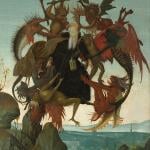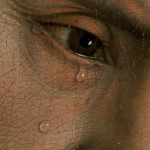“WHAT SEEMS LIKE AN INTERLUDE NOW/COULD BE THE BEGINNING OF LOVE“: On Christmas, I was speaking with someone who described a certain Christian response to the world as “indifference.” This distance from the events of the “stirring world” shows itself most clearly in law and politics: If they outlaw our practices in Pennsylvania, (shrug) no matter, we can move, or we can operate underground, it’s been done before. I asked whether this perspective took the attitude, “The blood of the martyrs is the seed of the church”–which I think is true, but not necessarily a good guide for political action!–and he replied, no, even that approach places a greater weight on the events of this world than the approach he was describing. He suggested this approach might spring from the Mennonite tradition; I hardly know, since I know virtually nothing about that tradition. But I was struck by how alien this approach seemed to me–it was a totally different way of looking at this world.
I can see how it would be a startling witness to Christ: God is so great that this world becomes irrelevant in comparison. But it seems to me like there’s more than a hint of Stoicism in this attitude–don’t look and it won’t hurt. (Can such a radical rejection of this life coexist with marriage? How would someone who has cultivated indifference to this life mourn the death of a spouse, or comfort those who mourn? It is an eschatological witness beyond even the poverty, celibacy, and obedience required of monks.) And there are other, and in my view better, ways of understanding how Christians should view the City of Man.
The God Who so surpasses this world’s glory has, after all, created this world, and plunged us into it. We have to figure out why. Is the world solely a negative sign, a cosmic “what not to do”? Or is there beauty and goodness in all that is, and our job to figure out how to discern and honor that beauty? There’s a hint of Stoicism in “Christian indifference,” and, I think, perhaps also a hint of Gnosticism: The divine spark within us is trapped in the flesh and rush and traditions and language of a God-forsaken world. There is something divine in us, the imago Dei, but the world is utterly alien to that divine thing. In the Catholic view, the world has been wrecked by sin, but as with all ruins, the original beauty still persists. God still shapes human language and tradition so that we might be able to apprehend Him.
Catholicism is famously an “incarnational” religion, a way of honoring “God with us,” God as He operates in the world. Hence all the candles and incense and statues and color and music. This life is not opposed to the next life; this interlude is, if we accept Christ, the beginning of endless love. I think this recognition of the insufficiency and importance of this life–its suffering and its struggles as much as its beauty–is why so many artists and writers are drawn to Catholicism. Art is no substitute for religion, but it is something, something real. This life is neither sufficient nor irrelevant. The same understanding of the importance of this life in light of the greater glory of the next produces the passion of Christian charity I talked about in “Religion Is the Amphetamine of the People.”











